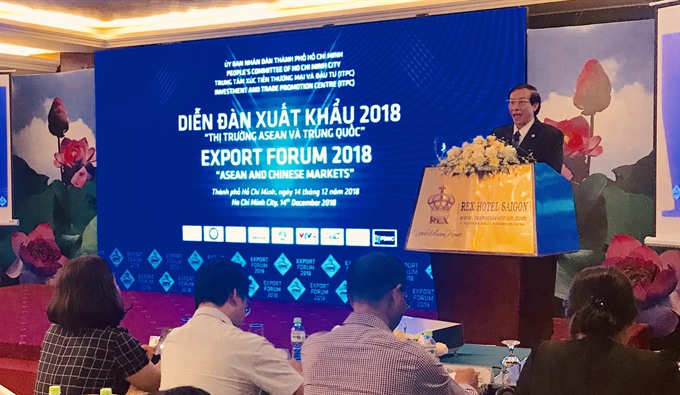 Economy
Economy

" />
 |
| Phạm Thiết Hòa, director of ITPC, speaks at the 2018 Export Forum: ASEAN-China Market yesterday in HCM City. VNS Photo Bồ Xuân Hiệp |
Phạm Thiết Hòa, director of the HCM City Investment and Trade Promotion Centre (ITPC), said that trade relations between Việt Nam and ASEAN countries had grown rapidly in recent years.
“ASEAN is Việt Nam’s fourth largest export market, after the EU, the US and China, he said.
ASEAN economies have a combined population of around 660 million and high economic growth, and Vietnamese firms now have greater opportunities than ever to export to them, according to Hòa.
The establishment of ASEAN Economic Community (AEC) three years ago is expected to open up many opportunities for Vietnamese businesses.
Compared to other trade agreements, commitments on tariff reductions in the AEC are the most favourable.
Việt Nam plans to complete the AEC tariff-reduction schedule by the end of the year, when tariffs will be cut to zero.
To tap into the ASEAN market, Hoà said that Vietnamese exporters should engage in more trade promotions and market surveys, and strengthen linkages with enterprises in target markets.
Exporters should also study prices, tastes and trends of consumers in other markets, and offer labels and packaging in English and in local languages.
To meet the requirements of the ASEAN market, enterprises should also build brands, apply technology in production to reduce costs, and improve designs to increase the added value of products.
“E-commerce is also essential,” Hoà added.
China market
China is the biggest trading partner of Việt Nam. Vietnamese exports to China reached $38.1 billion in the first 11 months, up 23.2 per cent year-on-year, which was higher than any other markets.
As of the end of October, bilateral trade between Việt Nam and China reached $86.9 billion, up 19 per cent year on year.
Last year, bilateral trade between the two countries totalled $93.7 billion. Exports of agricultural, forestry and fishery products were worth more than $8 billion, accounting for 35 per cent of Việt Nam’s total export turnover.
At the APEC summit held in Đà Nẵng last year, President Xi Jinping said that China would import goods worth more than $24 trillion over the next 15 years.
China has been Việt Nam’s largest trading partner for more than 10 consecutive years, and Việt Nam is one of China’s 10 largest trading partners, according to the consul general of China in HCM City.
The Chinese consulate said that Việt Nam’s government should research different trends in consumption markets and then issue suitable policies to help local exporters.
Exporters must learn about changing markets to sell the products that the market needs, instead of selling products the market already has, the consulate said.
Vietnamese enterprises should also improve the marketing of their products, especially to the Chinese market, through major events like the China-ASEAN Fair and Canton Fair, among others.
A traceability system to protect consumers and higher investment in warehousing and logistics to ensure faster delivery were also important.
Businesses and individuals should not sell poor quality products for short-term benefits, and instead should have a long-term vision to protect the reputation of the industry, according to the Chinese consulate.
Speaking at the meeting, Nguyễn Thị Ngọc Hằng, head of the marketing division of the Halal Certification Agency, said halal was a thriving industry worth $2.3 trillion in revenue each year globally, attracting not only Islamic countries but also non-Muslim countries.
The number of Muslims worldwide is 1.6 billion. With half of ASEAN’s population as Muslim, the halal industry in the ASEAN market has great potential and is continuing to grow, according to Hằng.
Bilateral trade between Việt Nam and ASEAN last year reached US$49.5 billion, a rise of 19.6 per cent over 2016, accounting for 11.7 per cent of the country’s total import and export turnover, according to the General Department of Customs.
Last year, total exports from Việt Nam to ASEAN were $21.51 billion, a surge of 23.9 per cent compared to 2016, accounting for 10 per cent of the country’s total exports.
The key exports included telephones and components, computers, electronics and components, iron and steel, machinery and spare parts, textiles, crude oil and petroleum, among others.
Việt Nam’s imports from ASEAN were $28.02 billion in 2017, up 16.4 per cent compared to 2016, accounting for 13.3 per cent of the country’s total imports from all markets.
The GDP of ASEAN reached $2.551 billion in 2016. The area is expected to become the world’s fourth largest market by 2030.
The 2018 Export Forum: ASEAN-China Market was organised by ITPC under the direction of the HCM City People’s Committee. — VNS




